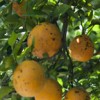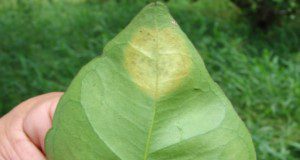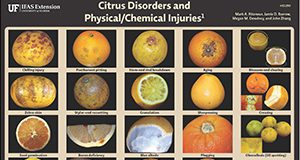This article is one in a series designed to provide important information on the causal agent, symptoms, and transmission of exotic citrus diseases. Disseminating the information about the diseases to the citrus industry may prevent their introduction and spread in Florida. This 5-page document will focus on the exotic viral disease citrus leprosis. This is a major revision of an article originally published in 2006. Written by O. Batuman, A. Levy, P. Sieburth, A. M. Paolillo, K.-R. Chung, and R. H. Brlansky, and published by the UF/IFAS Plant Pathology Department.
https://edis.ifas.ufl.edu/pp148
Tag: Citrus Diseases
Citrus Fruit Blemishes and Decay Caused by Fungi and Bacteria
This new one-page citrus identification fact sheet illustrates different blemishes from fungi and bacteria that affect citrus. Written by Mark A. Ritenour, Jamie D. Burrow, Megan M. Dewdney, and John Zhang and published by the Horticultural Sciences Department.
http://edis.ifas.ufl.edu/hs1291
Evolution of Citrus Disease Management Programs and Their Economic Implications: The Case of Florida's Citrus Industry (FE915)
 Managing new exotic endemic diseases is very costly, and it is imperative that state and federal governments focus on preventing the introduction of other diseases such as citrus variegataed cholorosis and citrus leprosis virus. This 6-page fact sheet focuses on the expanded costs of managing exotic citrus diseases as they become endemic or established within a citrus industry. Written by Ronald P. Muraro, and published by the UF Department of Food and Resource Economics, October 2012.
Managing new exotic endemic diseases is very costly, and it is imperative that state and federal governments focus on preventing the introduction of other diseases such as citrus variegataed cholorosis and citrus leprosis virus. This 6-page fact sheet focuses on the expanded costs of managing exotic citrus diseases as they become endemic or established within a citrus industry. Written by Ronald P. Muraro, and published by the UF Department of Food and Resource Economics, October 2012.
http://edis.ifas.ufl.edu/fe915
Mancha negra de los citricos (PP295)

Este documento es una hoja de dos páginas ilustrativas para la identificación de la mancha negra de los cítricos. This 2-page fact sheet was written by Megan M. Dewdney and Natalia A. Peres, and published by the UF Department of Plant Pathology, August 2012. http://edis.ifas.ufl.edu/pp295
Enfermedades Exoticos de los Citricos (PP296)
 Este documento es una hoja de dos páginas ilustrativas para la identificación de las enfermedades exóticas de los cítricos. This 2-page fact sheet was written by M. M. Dewdney, J. D. Burrow, M.E. Rogers, and T. M. Spann, and published by the UF Department of Plant Pathology, August 2012.
Este documento es una hoja de dos páginas ilustrativas para la identificación de las enfermedades exóticas de los cítricos. This 2-page fact sheet was written by M. M. Dewdney, J. D. Burrow, M.E. Rogers, and T. M. Spann, and published by the UF Department of Plant Pathology, August 2012.
http://edis.ifas.ufl.edu/pp296
Enfermedades fungicas foliares de los citricos para los patios y zonas residenciales (PP297)
 Este documento es una hoja de dos páginas ilustrativas para la identificación de las enfermedades fúngicas foliares de los cítricos. This 2-page fact sheet was written by M. M. Dewdney and J. D. Burrow, and published by the UF Department of Plant Pathology, August 2012.
Este documento es una hoja de dos páginas ilustrativas para la identificación de las enfermedades fúngicas foliares de los cítricos. This 2-page fact sheet was written by M. M. Dewdney and J. D. Burrow, and published by the UF Department of Plant Pathology, August 2012.
http://edis.ifas.ufl.edu/pp297
Citrus Diseases Exotic to Florida: Citrus Yellow Mosaic (PP293)
Citrus yellow mosaic is an important viral disease in India, where it causes significant yield reduction. In some groves, infection rate may be as high as 70%. CYMV induces a bright yellow mottling or vein flecking that persists in mature leaves. Yields are sharply reduced in chronically infected ‘Sathgudi’ sweet orange trees in India, and fruit may also show mosaic symptoms. This 2-page fact sheet was written by K.-R. Chung and R. H. Brlansky, and published by the UF Department of Plant Pathology, February 2012.
http://edis.ifas.ufl.edu/pp293
Citrus Diseases Exotic to Florida: Mal Secco (PP290)
 Mal secco, Italian for “dry disease”, is a fungal disease that causes serious damage to a number of citrus cultivars in the Mediterranean and Black Sea areas, but has not been reported in other citrus-growing regions. The main diagnostic field symptom is that wood of affected limbs has a reddish-yellow stain. This 3-page fact sheet was written by K.-R. Chung, and published by the UF Department of Plant Pathology, February 2012.
Mal secco, Italian for “dry disease”, is a fungal disease that causes serious damage to a number of citrus cultivars in the Mediterranean and Black Sea areas, but has not been reported in other citrus-growing regions. The main diagnostic field symptom is that wood of affected limbs has a reddish-yellow stain. This 3-page fact sheet was written by K.-R. Chung, and published by the UF Department of Plant Pathology, February 2012.
http://edis.ifas.ufl.edu/pp290
Citrus Diseases Exotic to Florida: Satsuma Dwarf (PP291)
 Satsuma dwarf is a virus disease that was first reported in the early 1930s in Japan. The disease causes serious problems in citrus because it reduces tree vigor and fruit yield. Satsuma dwarf has also been reported in mandarin-growing areas in China, Korea, and Turkey, where it was likely introduced through importation of infected budwood from Japan. This 2-page fact sheet was written by K.-R. Chung and R.H. Brlansky, and published by the UF Department of Plant Pathology, February 2012.
Satsuma dwarf is a virus disease that was first reported in the early 1930s in Japan. The disease causes serious problems in citrus because it reduces tree vigor and fruit yield. Satsuma dwarf has also been reported in mandarin-growing areas in China, Korea, and Turkey, where it was likely introduced through importation of infected budwood from Japan. This 2-page fact sheet was written by K.-R. Chung and R.H. Brlansky, and published by the UF Department of Plant Pathology, February 2012.
http://edis.ifas.ufl.edu/pp291
Citrus Diseases Exotic to Florida: Powdery Mildew (PP288)
 Powdery mildew, which affects almost all citrus cultivars, is a common fungal disease problem in Asian countries. This 2-page fact sheet provides background information for this disease to provide a basis for evaluating potential risk to Florida citrus and for aiding decision-making to prevent its introduction and spread in Florida. It was written by K.-R. Chung and published by the UF Department of Plant Pathology, October 2011.
Powdery mildew, which affects almost all citrus cultivars, is a common fungal disease problem in Asian countries. This 2-page fact sheet provides background information for this disease to provide a basis for evaluating potential risk to Florida citrus and for aiding decision-making to prevent its introduction and spread in Florida. It was written by K.-R. Chung and published by the UF Department of Plant Pathology, October 2011.
http://edis.ifas.ufl.edu/pp288
Exotic Citrus Diseases: Early Detection is the Solution to Protecting Florida Citrus (CH202)
This revised illustrated trifold brochure provides key information about Pseudocercospora fruit and leaf spot, sweet orange scab, citrus leprosis virus, citrus variegated chlorosis (CVC), and citrus tristeza virus (CTV) stem pitting. Includes contact information for UF/IFAS Extension citrus experts. Written by R. H. Brlansky, M. M. Dewdney, and J. D. Yates, and published by the UF Department of Plant Pathology, June 2010.
http://edis.ifas.ufl.edu/ch202
PP24/VH049 Florida Plant Disease Management Guide: ‘Tahiti’ Lime (Citrus latifolia)
Revised! PP24, a 9-page illustrated fact sheet by Tara Tarnowski, Aaron J. Palmateer, Ian Maguire, and Jonathan H. Crane, provides an overview of disease management for 'Tahiti' lime, with symptoms, casual organisms/agents, disease cycle and epidemiology, and management information for several key diseases. Includes references. Published by the UF Department of Plant Pathology, October 2009.
http://edis.ifas.ufl.edu/VH049
PP264 Exotic Diseases of Citrus Identification Sheet
PP264, a 2-page ID sheet by M.M. Dewdney, J.D. Yates, M.E. Rogers, and T.M. Spann, provides images for identification and comparison chart for Citrus Variegated Chlorosis (CVC), Leprosis, Citrus Black Spot, Sweet Orange Scab (SOS) and Citrus Tristeza Stem-Pitting (CTV-SP). Published by the UF Department of Plant Pathology, May 2009.
http://edis.ifas.ufl.edu/PP264
PP263 Citrus Greening, Blight and Tristeza Comparison Identification Sheet
PP263, a 2-page English/Spanish ID sheet by M.M. Dewdney, J.D. Yates, R.H. Brlansky, T.M. Spann, and M.E. Rogers, guides identification of Citrus Greening and provides a comparison chart for Citrus Greening, Blight and Tristeza. Published by the UF Department of Plant Pathology, May 2009.
http://edis.ifas.ufl.edu/PP263
CH202 Exotic Citrus Diseases: Early Detection is the Solution to Protecting Florida Citrus
CH202, a 2-page illustrated trifold brochure by J.D. Yates, M.M. Dewdney and R.H. Brlansky, is best viewed in pdf format. It provides key information about citrus blackspot, sweet orange scab, citrus leprosis virus, citrus variegated chlorosis (CVC), and citrus tristeza virus (CTV) stem pitting. Includes contact information for UF/IFAS Extension citrus experts. Published by the UF Department of Plant Pathology, November 2008.
http://edis.ifas.ufl.edu/CH202

